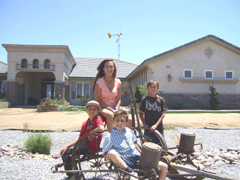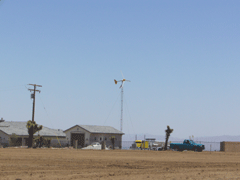Home Wind
Air Date: Week of June 15, 2007

Denise Cooley lives on a Cajon Pass looking over the high desert in San Bernardino Valley. With her are her three sons (from left to right), Michael 11, Matthew 8, John 13. (Courtesy Denise Cooley)
A piece of legislation sitting before the House Committee of Ways and Means would give homeowners a tax break for setting up a small wind-turbine in their backyard. But, in an effort to boost renewable energy, some states have already started to underwrite the costs of residential wind turbines. Living on Earth's Steve Curwood speaks to a home wind operator about her turbine in San Bernardino, CA.
Transcript
CURWOOD: Among all the energy bills on Capitol Hill is a House measure that would provide tax breaks to homeowners who put small wind turbines in their backyards.
And it would follow the lead of some states, which already subsidize home wind power. One of these is California, where homeowner Denise Cooley has put up small wind turbines at each of two houses she owns in San Bernardino, east of Los Angeles, and she’s on the line. Ms. Cooley, tell me, how's the wind blowing out there today?
COOLEY: Today?
CURWOOD: Yeah.
COOLEY: Actually not that good.
[BOTH LAUGH]
COOLEY: There’s hardly any current at all. But that’s ok because there’s other days when it makes up for it.
CURWOOD: So, tell me what you can see out your window. I’m wondering if you can see the turbine.
COOLEY: Oh, yeah. It’s only about 50 feet from the house. My house now, I live on a ledge and I have the windmill up on the top portion. It’s the best location where I can get the best current. The higher up it is, the better consumption you can get.
CURWOOD: So, this is about a 10-kilowatt generator, I gather. And how much power do you get over the course of a year?
COOLEY: It typically ranges about 12 to 13 thousand kilowatts.

Denise Cooley's windmill is a 10kW Bergey Excel Turbine and stands 80 feet tall. (Photo: John Cooley)
COOLEY: Actually it’s about 100 percent. It balances out some months are slow and some months are excessive and so at the end of the year you look at it, and like last year I only had a 15 dollar bill and that was for being connected to the Edison grid.
CURWOOD: And before you had a wind turbine how much was your annual bill for electricity?
COOLEY: I don’t know annually. I know monthly, I would pay about 3 to 400 dollars a month in electrical alone.
CURWOOD: And what do you use in your house?
COOLEY: The house right now is around 4,000 square foot.
CURWOOD: 4,000 square feet! That’s a big house.
COOLEY: It is a big house and that’s what’s so nice about it, is that I’m able to generate enough wind current and enough kilowatt that the house will consume about the same amount and it levels out. It’s a wash.
CURWOOD: So, you have two wind turbines.
COOLEY: Well, I have the one on my first house that is for sale. And I have one on my current house. And as I was designing this house I made sure that I switched the water heaters over to electric and I put in as many ceiling fans as I could and then on the stovetop and different things that might have been propane, I could switch to electric.
CURWOOD: And, so far, the system that you put in your new house is covering everything that you need?
COOLEY: It covers everything. I still pay about $1.73 every month to be connected to the Edison grid and be able to enjoy this wonderful opportunity.
CURWOOD: So, a lot of people think about getting windmills. What motivated you to make the decision to actually do this?
COOLEY: Well, you look in your heart and you might have a toy, or car or a boat. And that might be about 25 thousand. And so the windmill, after the rebates, is the same price. So, we just projected out how long it would take to get that money back and then after that period you’re getting even more back so why not invest in your own home? They say your principle residence is the best investment you’ll ever make. So, knowing that and wanting to keep the costs down, and be conservative and just know that it’s the right decision.

Denise Cooley lives on a Cajon Pass looking over the high desert in San Bernardino Valley. With her are her three sons (from left to right), Michael 11, Matthew 8, John 13. (Courtesy of Denise Cooley)
COOLEY: Originally, the system was about 44 or 45 thousand. In the last couple years the prices and materials and everything have gone up. So, my first one I paid about 45, 50 percent of that. So it came to about 24 thousand. My second one I paid about 26, 27 thousand.
CURWOOD: Now, right now on Capitol Hill the federal government is looking at a bill that would give tax credits to folks who put up residential wind energy projects. Uh how much of a good or bad idea do you think this is?
COOLEY: Oh, no, it’s excellent. If it wasn’t for the rebates and it helping out with the majority of the costs then people wouldn’t be able to do it because they’re not going to be in that house for 20, 30 years to where they’re going to want to invest in that.
CURWOOD: Now, when you put up a wind turbine in a neighborhood, the neighbors might have objected. Did any of them object, and what did you say to them?
COOLEY: A couple would stop and they would pretend like they wanted to get educated and ask me questions about it. And then they would say, “oh we just wanted to stop and see how loud, and noisy, and annoying it was.” And so for them they just already had the mindset that they didn’t like it. And that was ok. But then I had other neighbors asking intelligent questions and wanting to see the inverter and watch my meter run backwards because they though that was impossible. You hear about it all the time but if you can see something with your own eyes it make more sense.
CURWOOD: Denise Cooley, thank you so much for taking this time with me today.
COOLEY: Thank you, I enjoyed it.
Links
The American Wind Energy Association's small wind website
U.S. Department of Energy handbook on purchasing small wind turbine
Living on Earth wants to hear from you!
Living on Earth
62 Calef Highway, Suite 212
Lee, NH 03861
Telephone: 617-287-4121
E-mail: comments@loe.org
Newsletter [Click here]
Donate to Living on Earth!
Living on Earth is an independent media program and relies entirely on contributions from listeners and institutions supporting public service. Please donate now to preserve an independent environmental voice.
NewsletterLiving on Earth offers a weekly delivery of the show's rundown to your mailbox. Sign up for our newsletter today!
 Sailors For The Sea: Be the change you want to sea.
Sailors For The Sea: Be the change you want to sea.
 The Grantham Foundation for the Protection of the Environment: Committed to protecting and improving the health of the global environment.
The Grantham Foundation for the Protection of the Environment: Committed to protecting and improving the health of the global environment.
 Contribute to Living on Earth and receive, as our gift to you, an archival print of one of Mark Seth Lender's extraordinary wildlife photographs. Follow the link to see Mark's current collection of photographs.
Contribute to Living on Earth and receive, as our gift to you, an archival print of one of Mark Seth Lender's extraordinary wildlife photographs. Follow the link to see Mark's current collection of photographs.
 Buy a signed copy of Mark Seth Lender's book Smeagull the Seagull & support Living on Earth
Buy a signed copy of Mark Seth Lender's book Smeagull the Seagull & support Living on Earth

